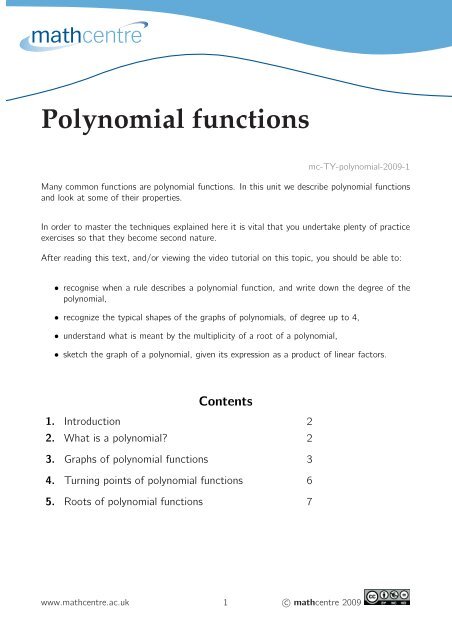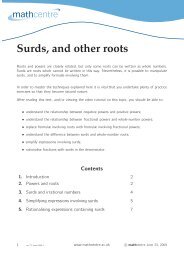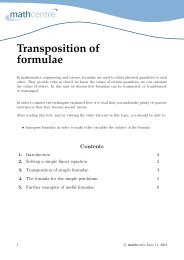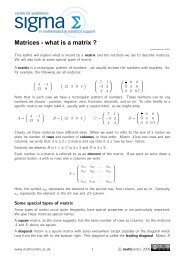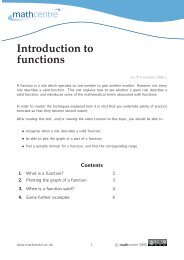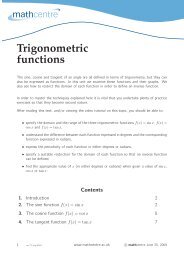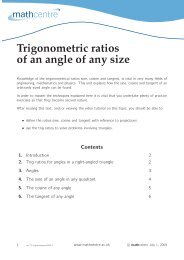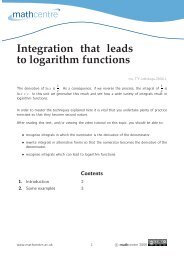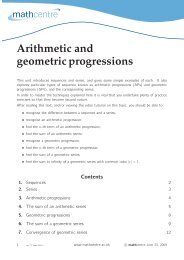Polynomial functions - Math Centre
Polynomial functions - Math Centre
Polynomial functions - Math Centre
Create successful ePaper yourself
Turn your PDF publications into a flip-book with our unique Google optimized e-Paper software.
<strong>Polynomial</strong> <strong>functions</strong>mc-TY-polynomial-2009-1Manycommon<strong>functions</strong>arepolynomial<strong>functions</strong>.Inthisunitwedescribepolynomial<strong>functions</strong>andlookatsomeoftheirproperties.Inordertomasterthetechniquesexplainedhereitisvitalthatyouundertakeplentyofpracticeexercisessothattheybecomesecondnature.Afterreadingthistext,and/orviewingthevideotutorialonthistopic,youshouldbeableto:•recognisewhenaruledescribesapolynomialfunction,andwritedownthedegreeofthepolynomial,•recognizethetypicalshapesofthegraphsofpolynomials,ofdegreeupto4,•understandwhatismeantbythemultiplicityofarootofapolynomial,•sketchthegraphofapolynomial,givenitsexpressionasaproductoflinearfactors.Contents1. Introduction 22. Whatisapolynomial? 23. Graphsofpolynomial<strong>functions</strong> 34. Turningpointsofpolynomial<strong>functions</strong> 65. Rootsofpolynomial<strong>functions</strong> 7www.mathcentre.ac.uk 1 c○mathcentre2009
1. IntroductionApolynomialfunctionisa<strong>functions</strong>uchasaquadratic,acubic,aquartic,andsoon,involvingonlynon-negativeintegerpowersof x. Wecangiveageneraldefintionofapolynomial,anddefineitsdegree.2. What is a polynomial?Apolynomialofdegree nisafunctionoftheformf(x) = a n x n + a n−1 x n−1 + . . . + a 2 x 2 + a 1 x + a 0wherethe a’sarerealnumbers(sometimescalledthecoefficientsofthepolynomial).Althoughthisgeneralformulamightlookquitecomplicated,particularexamplesaremuchsimpler. Forexample,f(x) = 4x 3 − 3x 2 + 2isapolynomialofdegree3,as3isthehighestpowerof xintheformula.Thisiscalledacubicpolynomial,orjustacubic.Andf(x) = x 7 − 4x 5 + 1isapolynomialofdegree7,as7isthehighestpowerof x.Noticeherethatwedon’tneedeverypowerof xupto7: weneedtoknowonlythehighestpowerof xtofindoutthedegree. Anexampleofakindyoumaybefamiliarwithisf(x) = 4x 2 − 2x − 4whichisapolynomialofdegree2,as2isthehighestpowerof x.Thisiscalledaquadratic.Functionscontainingotheroperations,suchassquareroots,arenotpolynomials.Forexample,f(x) = 4x 3 + √ x − 1isnotapolynomialasitcontainsasquareroot.Andf(x) = 5x 4 − 2x 2 + 3/xisnotapolynomialasitcontainsa‘divideby x’.ApolynomialisafunctionoftheformKey Pointf(x) = a n x n + a n−1 x n−1 + . . . + a 2 x 2 + a 1 x + a 0 .Thedegreeofapolynomialisthehighestpowerof xinitsexpression. Constant(non-zero)polynomials,linearpolynomials,quadratics,cubicsandquarticsarepolynomialsofdegree0,1,2,3and4respectively.Thefunction f(x) = 0isalsoapolynomial,butwesaythatitsdegreeis‘undefined’.www.mathcentre.ac.uk 2 c○mathcentre2009
3. Graphs of polynomial <strong>functions</strong>Wehavemetsomeofthebasicpolynomialsalready.Forexample, f(x) = 2isaconstantfunctionand f(x) = 2x + 1isalinearfunction.f (x)f (x) = 2x + 12 f (x) = 21xItisimportanttonoticethatthegraphsofconstant<strong>functions</strong>andlinear<strong>functions</strong>arealwaysstraightlines.Wehavealreadysaidthataquadraticfunctionisapolynomialofdegree2. Herearesomeexamplesofquadratic<strong>functions</strong>:f(x) = x 2 , f(x) = 2x 2 , f(x) = 5x 2 .Whatistheimpactofchangingthecoefficientof x 2 aswehavedoneintheseexamples? Onewaytofindoutistosketchthegraphsofthe<strong>functions</strong>.f (x)f (x) = 5x 2f (x) = 2x 2f (x) = x 2xYoucanseefromthegraphthat,asthecoefficientof x 2 isincreased,thegraphisstretchedvertically(thatis,inthe ydirection).Whatwillhappenifthecoefficientisnegative?Thiswillmeanthatallofthepositive f(x)valueswillnowbecomenegative.Sowhatwillthegraphsofthe<strong>functions</strong>looklike?The<strong>functions</strong>arenowf(x) = −x 2 , f(x) = −2x 2 , f(x) = −5x 2 .www.mathcentre.ac.uk 3 c○mathcentre2009
f (x)xf (x) = −x 2f (x) = −2x 2f (x) = −5x 2Noticeherethatallofthesegraphshaveactuallybeenreflectedinthe x-axis. Thiswillalwayshappenfor<strong>functions</strong>ofanydegreeiftheyaremultipliedby −1.Nowletuslookatsomeotherquadratic <strong>functions</strong> toseewhathappens whenwevarythecoefficientof x,ratherthanthecoefficientof x 2 .Weshalluseatableofvaluesinordertoplotthegraphs,butweshallfillinonlythosevaluesneartheturningpointsofthe<strong>functions</strong>.x −5 −4 −3 −2 −1 0 1 2x 2 + x 6 2 0 0 2 6x 2 + 4x 0 −3 −4 −3 0x 2 + 6x −5 −8 −9 −8 −5Youcanseethesymmetryineachrowofthetable,demonstratingthatwehaveconcentratedontheregionaroundtheturningpointofeachfunction. Wecannowusethesevaluestoplotthegraphs.f (x)f (x) = x 2 + xf (x) = x 2 + 4xxf (x) = x 2 + 6xAsyoucansee,increasingthepositivecoefficientof xinthispolynomialmovesthegraphdownandtotheleft.www.mathcentre.ac.uk 4 c○mathcentre2009
Whathappensifthecoefficientof xisnegative?x −2 −1 0 1 2 3 4 5x 2 − x 6 2 0 0 2 6x 2 − 4x 0 −3 −4 −3 0x 2 − 6x −5 −8 −9 −8 −5Againwecanusethesetablesofvaluestoplotthegraphsofthe<strong>functions</strong>.f (x)f (x) = x 2 − xf (x) = x 2 − 4xxf (x) = x 2 − 6xAsyoucansee,increasingthenegativecoefficientof x(inabsoluteterms)movesthegraphdownandtotheright.Sonowweknowwhathappenswhenwevarythe x 2 coefficient,andwhathappenswhenwevarythe xcoefficient. Butwhathappenswhenwevarytheconstanttermattheendofourpolynomial? Wealreadyknowwhatthegraphofthefunction f(x) = x 2 + xlookslike,sohowdoesthisdifferfromthegraphofthe<strong>functions</strong> f(x) = x 2 + x + 1,or f(x) = x 2 + x + 5,orf(x) = x 2 + x − 4?Asusual,atableofvaluesisagoodplacetostart.x −2 −1 0 1 2x 2 + x 2 0 0 2 6x 2 + x + 1 3 1 1 3 7x 2 + x + 5 7 5 5 7 11x 2 + x − 4 −2 −4 −4 −2 2Ourtableofvaluesisparticularlyeasytocompletesincewecanuseouranswersfromthe x 2 +xcolumntofindeverythingelse. Wecanusethesetablesofvaluestoplotthegraphsofthe<strong>functions</strong>.www.mathcentre.ac.uk 5 c○mathcentre2009
f (x)f (x) = x 2 + x + 5f (x) = x 2 + x + 1f (x) = x 2 + xf (x) = x 2 + x − 4xAswecanseestraightaway,varyingtheconstanttermtranslatesthe x 2 + xcurvevertically.Furthermore,thevalueoftheconstantisthepointatwhichthegraphcrossesthe f(x)axis.4. Turning points of polynomial <strong>functions</strong>Aturningpointofafunctionisapointwherethegraphofthefunctionchangesfromslopingdownwardstoslopingupwards,orviceversa.Sothegradientchangesfromnegativetopositive,orfrompositivetonegative. Generallyspeaking,curvesofdegree ncanhaveupto (n − 1)turningpoints.For instance, a quadratic has only one turningpoint.Acubiccouldhaveuptotwoturningpoints,andsowouldlooksomethinglikethis.However,somecubicshavefewerturningpoints: forexample f(x) = x 3 . Butnocubichasmorethantwoturningpoints.www.mathcentre.ac.uk 6 c○mathcentre2009
Inthesameway,aquarticcouldhaveuptothreeturningturningpoints,andsowouldlooksomethinglikethis.Again,somequarticshavefewerturningpoints,butnonehasmore.Key PointApolynomialofdegree ncanhaveupto (n − 1)turningpoints.5. Roots of polynomial <strong>functions</strong>Youmayrecallthatwhen (x − a)(x − b) = 0,weknowthat aand barerootsofthefunctionf(x) = (x − a)(x − b). Nowwecanusetheconverseofthis,andsaythatif aand bareroots,thenthepolynomialfunctionwiththeserootsmustbe f(x) = (x − a)(x − b),oramultipleofthis.Forexample,ifaquadratichasroots x = 3and x = −2,thenthefunctionmustbe f(x) =(x−3)(x+2),oraconstantmultipleofthis.Thiscanbeextendedtopolynomialsofanydegree.Forexample,iftherootsofapolynomialare x = 1, x = 2, x = 3, x = 4,thenthefunctionmustbef(x) = (x − 1)(x − 2)(x − 3)(x − 4),oraconstantmultipleofthis.Letusalsothinkaboutthefunction f(x) = (x − 2) 2 .Wecanseestraightawaythat x − 2 = 0,sothat x = 2. Forthisfunctionwehaveonlyoneroot. Thisiswhatwecallarepeatedroot,andarootcanberepeatedanynumberoftimes. Forexample, f(x) = (x − 2) 3 (x + 4) 4 hasarepeatedroot x = 2,andanotherrepeatedroot x = −4. Wesaythattheroot x = 2hasmultiplicity3,andthattheroot x = −4hasmultiplicity4.Theusefulthingaboutknowingthemultiplicityofarootisthatithelpsuswithsketchingthegraphofthefunction.Ifthemultiplicityofarootisoddthenthegraphcutsthroughthe x-axisatthepoint (x, 0). Butifthemultiplicityiseventhenthegraphjusttouchesthe x-axisatthepoint (x, 0).Forexample,takethefunctionf(x) = (x − 3) 2 (x + 1) 5 (x − 2) 3 (x + 2) 4 .•Theroot x = 3hasmultiplicity2,sothegraphtouchesthe x-axisat (3, 0).www.mathcentre.ac.uk 7 c○mathcentre2009
•Theroot x = −1hasmultiplicity5,sothegraphcrossesthe x-axisat (−1, 0).•Theroot x = 2hasmultiplicity3,sothegraphcrossesthe x-axisat (2, 0).•Theroot x = −2hasmultiplicity4,sothegraphtouchesthe x-axisat (−2, 0).Totakeanotherexample,supposewehavethefunction f(x) = (x − 2) 2 (x + 1). Wecanseethatthelargestpowerof xis3,andsothefunctionisacubic. Weknowthepossiblegeneralshapesofacubic,andasthecoefficientof x 3 ispositivethecurvemustgenerallyincreasetotherightanddecreasetotheleft.Wecanalsoseethattherootsofthefunctionare x = 2andx = −1. Theroot x = 2hasevenmultiplicityandsothecurvejusttouchesthe x-axishere,whilst x = −1hasoddmultiplicityandsoherethecurvecrossesthe x-axis.Thismeanswecansketchthegraphasfollows.f (x)−12xKey PointThenumber aisarootofthepolynomialfunction f(x)if f(a) = 0,andthisoccurswhen (x−a)isafactorof f(x).If aisarootof f(x),andif (x − a) m isafactorof f(x)but (x − a) m+1 isnotafactor,thenwesaythattheroothasmultiplicity m.Atarootofoddmultiplicitythegraphofthefunctioncrossesthe x-axis,whereasatarootofevenmultiplicitythegraphtouchesthe x-axis.Exercises1.Whatisapolynomialfunction?2.Whichofthefollowing<strong>functions</strong>arepolynomial<strong>functions</strong>?(a) f(x) = 4x 2 + 2 (b) f(x) = 3x 3 − 2x + √ x (c) f(x) = 12 − 4x 5 + 3x 2(d) f(x) = sin x + 1 (e) f(x) = 3x 12 − 2/x (f) f(x) = 3x 11 − 2x 12www.mathcentre.ac.uk 8 c○mathcentre2009
f (x)f (x) = 4x 2f (x) = x 2xf (x) = −x 2f (x) = −4x 25.(a) When a > 0,theparabolamovesdownandtotheleftas aincreases.(b) When a < 0,theparabolamovesdownandtotherightas adecreases.6.(a) 1turningpoint(d) (n − 1)turningpoints.(b) 2turningpoints (c) 11turningpoints7.(a) f(x) = (x − 1)(x − 2)(x − 3)(x − 4)oramultiple(b) f(x) = (x − 2)(x + 4)oramultiple(c) f(x) = (x − 12)(x + 1)(x + 6)oramultiple.8.(a) x = 2x = −4(b) x = 1x = −2x = 4oddmultiplicityevenmultiplicityoddmultiplicityevenmultiplicityoddmultiplicitywww.mathcentre.ac.uk 10 c○mathcentre2009
9)f (x)f (x) = (x − 1) 2 (x + 3)f (x) = (x − 2) 2 (x + 1)xwww.mathcentre.ac.uk 11 c○mathcentre2009


